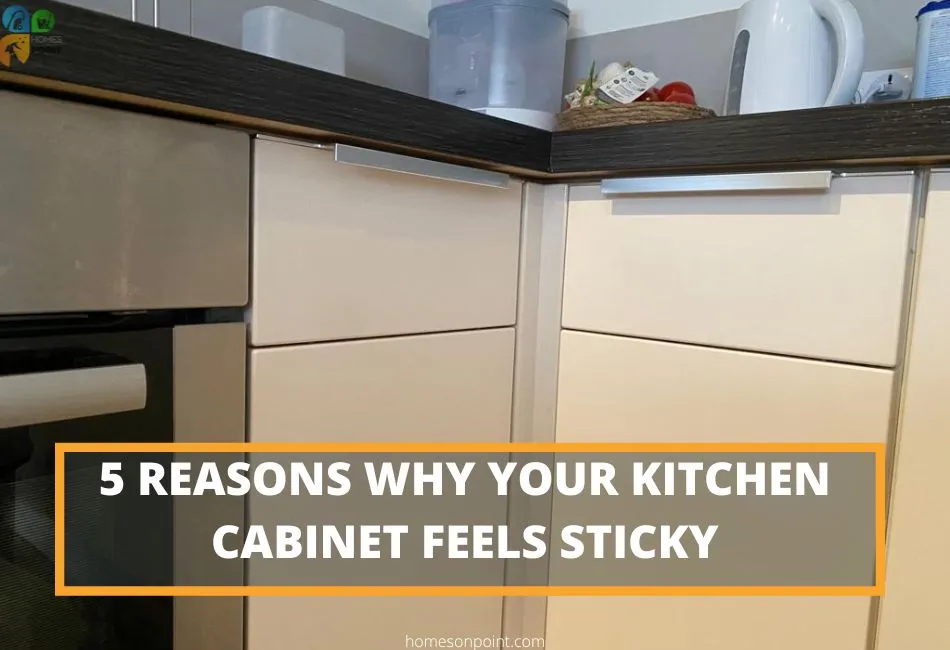Does your kitchen cabinet feel sticky when you touch it? Are you wondering what could have possibly caused that? Perhaps, you are looking for ways to completely get rid of that sticky feel on the shelves of your kitchen cabinets.
In this article, I will discuss some of the reasons why your kitchen cabinet feels sticky. I will also show you how you can easily fix that problem without necessarily breaking the bank.
5 Reasons Why Your Kitchen Cabinet Is Sticky
You would think that there was no possibility of having a sticky feel on your cabinets after you have cleaned them. However, whether your kitchen cabinets have been cleaned or not, there is a tendency for them to feel sticky. Here are some causes of sticky kitchen cabinets:
1. Oil Residue
Oil splatter is bound to settle on surfaces, including your kitchen cabinets. While cooking your meals, vapor can carry bits of oil onto your kitchen surfaces and after the condensed vapor dries up, the oil residue will be left on those surfaces making them sticky.
Even worse, when dust collects on top of this oil residue, it leaves your kitchen cabinets and surfaces feeling stickier and dirtier.
Again, if you do not wash, wipe and dry your oily utensils properly, they are bound to leave oil residue on your kitchen cabinets. So even if your kitchen cabinets are clean but your utensils are not well cleaned, you may eventually notice that sticky feel.
2. Humidity
The build-up of moisture in your kitchen cabinet can result in a sticky feeling in there. High levels of humidity in your kitchen cabinets result in layers of moisture on cabinet surfaces which can penetrate the surface of the cabinet causing it to become sticky or tacky.
This is especially true if your kitchen cabinet is made of materials that are very sensitive to moisture such as particleboard.
3. Insects And Pests
Ants and cockroaches and other insects can leave your kitchen cabinets feeling sticky. This is because insects leave behind secretions and other residues that easily adhere to surfaces. Once they are present in your kitchen cabinets, they will leave residues behind, causing the surface of your kitchen cabinet to become sticky.
Furthermore, some of these insect residues attract other insects making the problem worse.
4. Cleaning Products
If you notice any stickiness after cleaning your kitchen cabinets after cleaning, the problem could be from your cleaning products.
If you fail to properly wipe off the cleaning products from the surface of your kitchen cabinets, it can leave some stickiness behind. Be sure to wipe your cabinets with a microfiber cloth and ensure the cabinets are completely dry before arranging any items in there.
Moreover, using the wrong cleaning products can cause your kitchen cabinets to feel sticky after cleaning. My word of advice is to never use harsh cleaning products on your kitchen cabinets. Always use mild detergents and cleaning products on your kitchen cabinets to prevent stickiness.
5. Aging
If your kitchen cabinets are still sticky after cleaning then, there is the possibility that they have aged. Old kitchen cabinets tend to feel sticky sometimes as they have endured a lot. Food spills, dust, dirt, humidity, cleaning products, grease, these old kitchen cabinets have seen it all.
Therefore, even after thoroughly cleaning, your kitchen cabinets and you notice stickiness, there is a chance that your cabinets have aged. If you can afford to, you may have to install new kitchen cabinets, so you don’t have to deal with the stickiness anymore.
Otherwise, a more budget-friendly way will be to use cabinet liners to hide the stickiness.
What Is The Best Cleaner For Sticky Kitchen Cabinets
The best cleaner for sticky kitchen cabinets is a combination of things you may even already have in your kitchen. Using the correct proportions of water, vinegar, mild detergent, and/or baking soda, you can get rid of stickiness in your kitchen cabinets.
Alternatively, there are specific cleaning products on the market that can help to get rid of the stickiness in your kitchen cabinets. Most of these products are equally inexpensive. Read on to know how to correctly mix up and use the aforementioned home remedies.
How To Get Rid Of Sticky Cabinet Surface
There are three distinct ways you can employ to get rid of sticky cabinet surfaces.
1. Warm Water And Mild Detergent
If your cabinet surface is only slightly sticky, you can wipe off any dust with a dry cloth. Then, mix some mild detergent into warm water.
Using a damp cloth, apply the soapy water on the cabinet surface, in circles gently rub the damp cloth with soapy water on the surface of the cabinet. Apply a considerable amount of pressure where needed to get rid of a stubborn stain.
Then use clean warm water to completely wipe down the cabinet surface. Then leave to dry completely.
Alternatively, you can pour the soapy water into a spray bottle and spray it on the cabinet surface. Wipe the surface with clean warm water after spraying it with soapy water and allow the surface to dry completely. This will get rid of the stickiness.
2. Vinegar/Baking Soda And Water
For tougher forms of stickiness on your cabinet surface, use a mixture of vinegar or baking soda and water in the proportion of 0.5:1. Then add a few drops of dishwashing soap.
Now, apply or spray the mixture on the sticky cabinet surface and leave for a few minutes. Then, using a damp microfiber cloth, wipe the cabinet surface and follow up with a clean dry cloth. Allow the cabinet to dry completely.
3. Specialized Cleaning Product
If you are not about the DIY life, it’s certainly ok. Hit the stores and find any good cleaning product that is marketed to take care of sticky cabinet surfaces.
Simply follow the instructions on the product to get rid of those sticky cabinet surfaces. In all cases, make sure to wipe off all of the cleaning product and allow the surface to dry completely.
Simple Ways To Prevent Sticky Residue On Your Kitchen Cabinet
1. Regular Cleaning
The ultimate way to prevent sticky residue on your kitchen cabinet is to clean it regularly. Once you realize there is an oil splatter on your kitchen cabinet, clean it immediately using natural and non-harsh cleaning products.
Even if there is no oil splatter, maintain a regular cleaning culture when it comes to your kitchen cabinets. Doing this will prevent that sticky feeling in your kitchen cabinets for as long as possible.
2. Using Non-Adhesive Cabinet Liners
If you cannot clean your kitchen cabinet regularly, you can use non-adhesive cabinet liners to protect it from sticky residue. In the worst-case scenario, the cabinet liners are what will suffer from the sticky and thus need to be changed from time to time.
3. Coasters And Mats
For the cabinet surfaces especially, you can use coasters and mats to essentially catch any liquids and oils that have the potential of making the surface feel sticky after having settled on it.
Do not put hot or potential liquid spilling things such as cold bottled water directly on top of your kitchen cabinet.
4. Use The Right Cleaning Products
Using the right cleaning products can help get rid of stickiness in your kitchen cabinets and prevent it from happening again. Simple homemade products like vinegar and baking soda, used together with mild detergent and warm water can help get rid of the stickiness in your kitchen cabinets.
So, aside from cleaning your cabinets regularly, make sure you’re using the right cleaning products to prevent any stickiness in the future.
5. Aerate
After sticking to a cleaning routine for your kitchen cabinets, you should also ensure the insides are well-ventilated. Seeing as high humidity is one of the causes of stickiness in kitchen cabinets, it is advisable to ensure that there is a free flow of air in your kitchen cabinets.
Conclusion
Different portions of your kitchen cabinets may be feeling sticky due to oil residue, high humidity, incorrect use of cleaning products, insects, and prolonged use of the cabinets. When you notice this stickiness, however, all hope is not lost. By using some household finds and specialized cleaning products, you can get rid of the stickiness.

